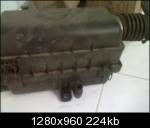ok guys I am not sure but think it might as well be the crankcase emission control system and not the maf sensor
Heres a pic of the hyundai air filter and you can see the point where this so called "idling" pipe connects

also i checked the hyundai manual for an maf sensor but it doesnt talk about that. it does however talk about emission control systems and heres what it says about the crankcase emission control system the santro is equipped with "The Positive Crankcase Ventilation System is employed to prevent air pollution caused by blow-by gases emitted by the crankcase. This system supplies fresh filtered air to the crankcase through the
air intake hose. Inside the crankcase the fresh air mixes with the blow-by gases, which then pass through the PCV valve and into the induction system"
Now in the explanation above is the "air intake hose" our culprit "idling" hose. Also heres what i got from wikipedia
PCV valve - Wikipedia, the free encyclopedia
"The PCV valve is only one part of the PCV system, which is essentially a variable and calibrated air leak, whereby the engine returns its crankcase combustion gases. Instead of the gases being vented to the atmosphere, gases are fed back into the
intake manifold, to re-enter the combustion chamber as part of a fresh charge of air and fuel. The PCV system is not a classical "vacuum leak." Remember that
all the air collected by the air cleaner (and metered by the mass air flow sensor, on a fuel injected engine) goes through the intake manifold anyway. The
PCV system just diverts a small percentage of this air via the breather to the
crankcase before allowing it to be drawn back in to the intake tract again. It is an "open system" in that fresh exterior air is continuously used to flush contaminants from the crankcase and into the combustion chamber. The system relies on the fact that, while the engine is running, the intake manifold's air pressure is always less than crankcase air pressure. The lower pressure of the intake manifold draws air towards it, pulling air from the breather through the crankcase (where it dilutes and mixes with combustion gases), through the PCV valve, and into the intake manifold.
The PCV system consists of the breather tube and the PCV valve. The
breather tube connects the crankcase to a clean source of fresh air, such as the air cleaner body. Usually, clean air from the air cleaner flows in to this tube and in to the engine after passing through a screen, baffle, or other simple system to arrest a flame front, to prevent a potentially explosive atmosphere within the engine crank case from being ignited from a
back-fire in to the intake manifold. The baffle, filter, or screen also traps oil mist, and keeps it inside the engine.
Once inside the engine, the air circulates around the interior of the engine, picking up and clearing away combustion byproduct gases, including a large amount of water vapor, then exits through a simple baffle, screen or mesh to trap oil droplets before being drawn out through the PCV valve, and into the intake manifold."
So is our "idling" pipe the breather tube of the PCV system and now in my santro is just left hanging to take in air in the engine bay and then send same to crankcase. Why does the engine shut off when this inlet is closed?
I feel we are getting close to the answer if this is right direction

However i am still confused what damage this can cause, given that earlier it was getting fresh air from somewhere in the airfilter








 dont tell me i need to take it out - man such a waste of 8.2k if i need to go back to stock
dont tell me i need to take it out - man such a waste of 8.2k if i need to go back to stock 

 the neighbours must be really irritated by now with me turning the autocop on and off every 15 mins to check out stuff under the hood and then followed by a loud thud of closing the hood!!
the neighbours must be really irritated by now with me turning the autocop on and off every 15 mins to check out stuff under the hood and then followed by a loud thud of closing the hood!!